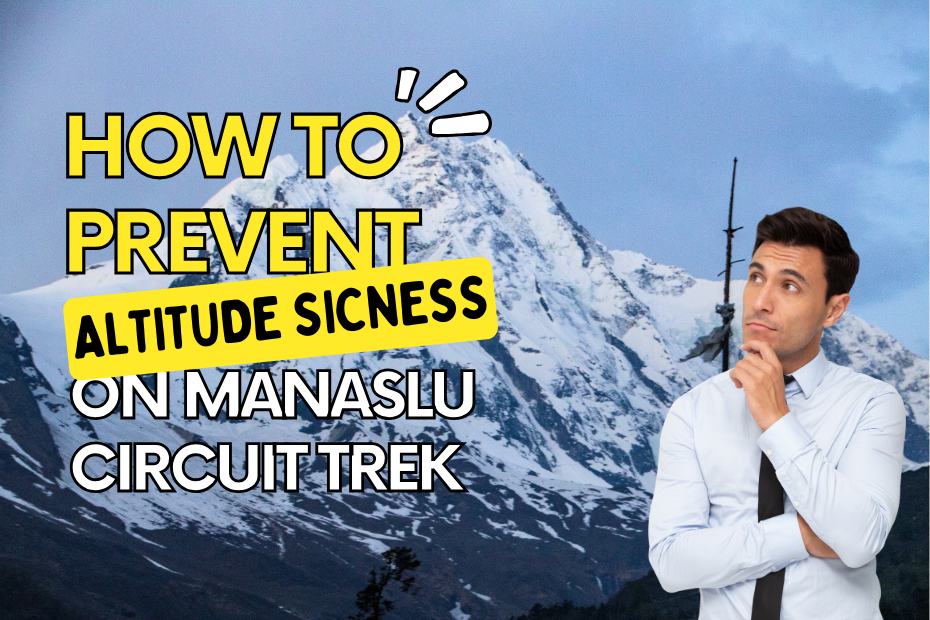How to Prevent Altitude Sickness on Manaslu Circuit Trek?

Manaslu Circuit Trek is one of the finest treks located around 50 miles from the capital city of Kathmandu. Exploring the hidden beauty of Manaslu Valley and Larkya La Pass during this trek will be beyond your imagination. Trekking in Manaslu (8,163 meters) Eighth-highest mountain, is an adventurous and equally challenging task, especially due to altitude sickness. It requires a high level of adventurous spirit, training, planning, and preparation.
Manaslu Circuit and other famous treks are adventurous and equally challenging. Many trekkers, especially beginners, think about how they can handle the higher elevation. Manaslu Circuit Trek kicks off in Machha Khola, situated at an elevation of 700 meters.
Each day, you will trek to new heights to the summit. The main and common issue that many trekkers face during such a trek is altitude sickness. Every trekker should know about altitude sickness while trekking in a high-altitude area.
This article is here to give related information about altitude sickness, its symptoms, preventive measures, and tips to avoid it. Continuing reading so that it helps you during your trek because altitude sickness can happen to anyone.
Must Check: Perfect Manaslu Circuit Trek Itinerary with AcclimitizationTable of Contents
What is Altitude Sickness?
When you go up to higher places, the air pressure decreases, and there’s less oxygen in the air. People can live okay in somewhat high areas, but the body needs time to get used to it. If you go above 3,000 – 4,000 meter, you might start feeling uncomfortable or even get into some risky situations because of the altitude change.
Types of Altitude Sickness
Acute Mountain Sickness (AMS):
When you go up to really high places, you might get sick, but it’s usually not too serious. This sickness is called acute mountain sickness. People climbing tall mountains or skiing in high places like Colorado might get it. If you start feeling sick, going down to a lower place helps a lot. Even waiting a bit before going higher can make the sickness go away if it’s not too bad. This kind of sickness usually shows up 8 to 36 hours after you go up.
Symptoms
- Headache
- Nausea or vomiting
- Dizziness or lightheadedness
- Weakness or fatigue
- Difficulty sleeping
- Loss of appetite
High Altitude Pulmonary Edema (HAPE)
High Altitude Pulmonary Edema (HAPE) is a serious type of sickness that happens when you go up really high, more severe than regular altitude sickness. It’s caused by too much fluid building up in the lungs, making it hard to breathe. This condition is life-threatening and occurs when you go up to high places too quickly. Going up too fast, doing a lot of physical activity, and not taking mild sickness seriously can lead to HAPE.
Symptoms
- Headache(gets worsening) and vomiting
- Walking with a staggering gait
- Confusion and Exhaustion
- Hallucinations (seeing things that are not real)
- Changes in the ability to think
- Changes in normal behavior
- Coma (in advanced cases)
High Altitude Cerebral Edema (HACE)
High Altitude Cerebral Edema (HACE) is a very serious and uncommon type of altitude sickness. It happens to people who go really high, like above 6000 meters. If you don’t take care of the early signs of altitude sickness or the more severe forms like HAPE, and you keep going higher, you might get HACE. This is when the brain swells because of the changes that happen in the body at high altitudes. If you don’t go down to lower places and get treated quickly, it can lead to a coma and, sometimes, even death.
Symptoms
- Chest tightness
- Extreme fatigue and inability to catch your breath, even when resting
- Blue or gray lips and fingernails
- Coughing, which may produce pink frothy fluid
- Fever (temperature is above normal but is less than 101° Fahrenheit)
- Noises when breathing, such as rattling or gurgling sounds
Preventive Measures for Altitude Sickness on Manaslu Circuit Trek
Climb slowly
When you’re going up to really high places, your body needs time to get used to the new environment. So, instead of going fast, take it slow and let your body adjust. Don’t drive straight to high places; choose lower spots to stay if you’re driving.
If you’re trekking to a high area like the Manaslu region, plan your journey with breaks at lower spots before reaching your final stop. Only climb up to 1,000 feet each day, and take a break day for every 3,000 feet you go up.
Eat carbs
When you’re up high, you need more energy, even though eating too many carbs isn’t the best. So, bring along lots of healthy snacks, especially ones with whole grains, to give you the extra calories you need.
Avoid alcohol
Drinking alcohol, smoking, and using sleeping pills increase the heartbeat rate. So, it can make altitude sickness worse. So, it’s better to avoid them when you’re trekking to high places like Manaslu Base Camp.
Drink water
Keep yourself hydrated all the time, not only in trekking. It helps to avoid altitude sickness. Make sure to carry a water bottle and drink regularly as you go up.
Take it easy
Climb at a speed that feels comfortable for you. Don’t push too hard or do heavy exercises during trekking days.
Sleep lower
Altitude sickness gets worse when you’re sleeping, especially at night time. It’s a good idea to climb higher only during the day and then come down to a lower place to sleep.
Medication

Normally, doctors only prescribe medicine in advance if you’re certain to go to a high place by flying or driving. There’s some proof that taking Diamox two days before and during your trek can help prevent altitude sickness, but your doctor needs to prescribe it.
It’s crucial to understand that even if you take Diamox, you can still get altitude sickness. If you start feeling symptoms, the medicine won’t make them go away. The best thing to do is to get to a lower place to treat altitude sickness. Medicine like Diamox only helps to prevent it, but they do not cure altitude sickness.
Manaslu Circuit Trek Acclimatization
Acclimatization is the key thing to avoid altitude sickness. For the Manaslu Circuit Trek, where you’ll be going from a low point of 710 meters to a high point of 5,105 meters, acclimatization is super important. You should strictly follow the itinerary given by the trekking agency. They are designed in such a way that it helps to make your journey comfortable and avoid issues like altitude sickness.
When To Call A Professional?
If someone is feeling sick from the altitude, they might not know it’s happening or that it’s getting worse. If you’re with someone who has these symptoms, help them go down to a lower place and try to find a doctor as soon as possible.
Worth reading: A complete Guide on Manaslu Circuit TrekThe Final Say
For trekkers, especially those who haven’t done trekking at high altitudes, such as the Manaslu Circuit Trek, altitude sickness is a big challenge. They should make the perfect plan and the right preparation to avoid it.
There is always a risk while doing adventurous things, whether trekking or other stuff. With super dedication, pushing the limit, and challenging yourself, the result will always be worth it. Manaslu Circuit trek has been successfully completed by thousands of trekkers with the help of trekking agencies like us. So, if you want to experience this once-in-a-lifetime adventure with us, then contact us or find us on WhatsApp.
Posted on








